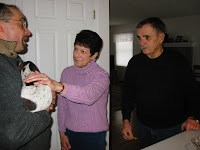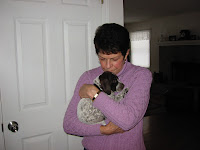Saturday morning, September 9, my wife's birthday, was cold, breezy, and wet, but the weather steadily improved as the day progressed. Friday night Bruno and I camped at the
KOA Campgrounds just north of
Muskegon, Michigan. We awoke early to arrive at the Michigan Chapter's
NAVHDA Test Grounds to compete in the Natural Ability Test for puppies up to 16 months old. Bruno was a mere 8.37 months old at test time. He was scheduled to run at 10:30 a.m. and by that time, the conditions were near perfect for a bird dog to perform his magic. And that he did scoring perfect scores for Use of Nose, Search, Water Ability (swimming to fetch two dummies thrown a ways out from shore), Pointing, Tracking (the part of the test on which most puppies score poorly), Desire to Work, and Cooperation for a perfect total score of 112 and a Prize I award. I was so proud of him!
Bruno overcame several challenges during the Natural Ability Test. During the first 20-minute part of the test,
NAVHDA judges Butch Grover, Lisa
Pehur, and Michael
Garriott observed and evaluated Bruno's use of nose, desire to work, cooperation (obedience to commands), and his searching and pointing abilities in an 80-acre field into which two
chukars were released. I became a little concerned after ten minutes into this segment for Bruno hadn't yet found a bird. Shortly after the halfway point of the field portion of the natural ability test, Bruno started to become very
birdy, but he couldn't find the bird I knew from his actions was nearby. The judges surprisingly expressed concern that time was running short and encouraged me (I felt they actually pressured me) to move Bruno to a new place to find birds, but I resisted. I could tell that Bruno was working a bird and that it was
close by. Within seconds, he nailed the bird with a rock solid point. I walked ahead of Bruno to flush the bird and confirm that his point was true, and in doing so, the three judges and I were very surprised to learn that the bird had been running and hiding in a foot-deep, dry irrigation channel that was completely covered by thick vegetation. This field in was the judge Butch Grover's home chapter training grounds and he said that he had trained in this field for years and never knew that this shallow, narrow irrigation ditch existed!
Well, Bruno wasn't done yet. In the next nine minutes, he proceeded to quickly locate and firmly point six more
chukars. Obviously, some of the puppies that field tested earlier in the morning hadn't found all their birds! Bruno's field performance here greatly impressed us all!
The next big challenge Bruno faced was the tracking part of the natural ability test. This is the part that most puppies either fail or perform poorly on. A rooster pheasant has its primary wing feathers pulled so that it cannot fly. A judge then plucks 2-3 breast feathers from the bird and places them on the ground of a closely-cropped field (typically the ground cover in the tracking field is only 2-4 inches high) where the bird is released and driven on foot by the judges across the tracking field 50-80 yards into a new area that offers more dense cover, such as a woods or corn or bean field. The dog handler and puppy are placed behind a barrier so that they cannot see the release of the bird and where the bird runs. After the judges had prepared and released the rooster, they called Bruno and me to come forward to the bird release site that was located forty yards from the blind behind which were instructed to stay. But along the way to the bird release site, we had to travel along a hedge-and-tree row into which Bruno turned suddenly and squarely to point a hiding rooster that had eluded its puppy during an earlier tracking session and somehow sneaked back undetected toward the bird release area.
"Wonderful!" I sighed to the judge who accompanied Bruno and me as we walked from behind the blind to the starting area. "What's this rooster doing here?! This could prove to be a distraction for my pup and keep him from focusing on tracking the released bird."
"Well, do the best you can," he said, as we arrived at the bird release site, where I received even more great news.
"You're going to have a tough track," the judge who released the rooster greeted us. "Upon release, your rooster jumped forward a good eight yards and then another four to six more yards quickly after that." He then proceeded to explain the test, the expectations for the puppy and how the judges evaluate the puppy's performance. "Any questions?"
"Yeah, can we start over and release a new bird?" I asked jokingly to break the tension that presided the release site.
"Good luck."
I took a moment and knelt down beside Bruno who was standing in the heel position, placed my left arm around his front shoulders, and confidently whispered encouragement into his right ear. Then I firmly commanded him aloud,"Find bird. Find!" As I released him I silently prayed for divine guidance and assistance. Bruno and I had trained solidly for three weeks to improve his bird tracking abilities. It was show time now--do or die. After commanding and releasing the puppy to track, find (point), and retrieve the bird, the handler is required to stand completely still and not say anything to his puppy. The emotions that raced through me after releasing Bruno ranged from hopeful optimism and confidence when he seemed to be tracking the bird well to helpless panic and despair when he seemed to momentarily have lost the bird's track and scent.
NAVHDA's Natural Ability Tracking Test is as agonizingly tortuous for the handler as it is tremendously challenging for the puppy. The test demands their total concentration. One distraction and the puppy is off-track.
Bruno blew right through the rooster's initial lengthy hops and appeared to be hot on its trail!
"That's it, buddy! Find!" I cheered for him in my mind. Bruno appeared to be tracking the rooster confidently for the first 25 yards, then suddenly he reached an area where he seemed uncertain as to the direction the bird had run. For what seemed to me to be tens of heart-palpitating minutes he searched back and forth across this area for bird scent but in reality after just a few moments of searching caught scent began
confidently tracking the bird again.
Seventy yards from the starting point, Bruno crossed a ditch and proceeded into thicker cover where from his appearance I knew he was hot on the bird's trail.
"He's close!" I thought. Then boom! Bruno squared staunchly on point. The rooster was hiding under a thick mat of cover in the ditch. He then raced into the ditch, grabbed the bird and jogged calmly and confidently back to deliver the live rooster to my hand! I was one proud papa!
The judges were so impressed by Bruno's performance on all portions of the natural ability test, they gave Bruno at age 8.37 months a top and perfect score of 112 and Prize I!
Atta a boy, Bruno! Well done! What a birthday present to bring home to my wife!













